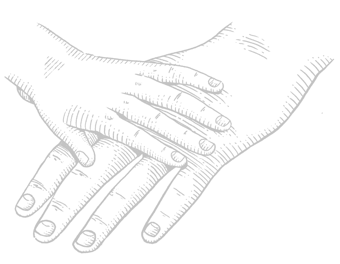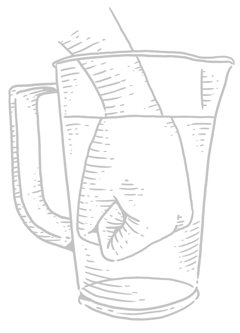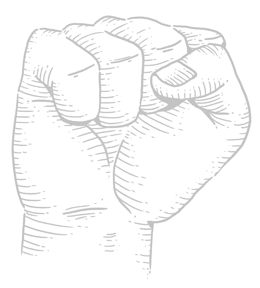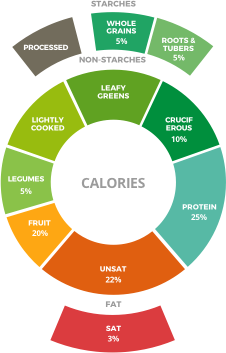¡How much should I eat!
ONCE SIZE DOES NOT FIT ALL…

There are not two single human beings are alike and that’s the premise for developing a healthy, nutritional and personalized diet program. We cannot have the same amounts and kinds of foods our neighbors, friends, and family members eat even if we have similar heights, weights and ages. Eating like others will produce different results for each of us and that is why two individuals following the same diet plan will have different results.
The food we eat must fit our body and personal needs, sleep, stress, and activity levels to achieve the optimal nutritional requirements and help fulfill our goals. It must be personalized to be truly successful.
Did you know there is a correlation between the food we eat and our hands?
Yes. For a healthy meal that accomplishes our objectives the SIZE OF OUR HANDS will help visualize and determine the ideal volume of the food-groups served on our plate.

Determining Our ideal Volume of Carbs, Protein and Starches
Frequently when we dine out or eat at home we receive a plate of food and never know if we are going to be served enough, too much, or the right amount for our body.
The plate arrives with so much food it seems fit for a king or has such scarce amounts its feels like “nouvelle cuisine” created for a very thin supermodel. Either way we end up leaving a lot of food on the plate, feeling too full, or still hungry.
1. So how do we measure the amount of food in our plate without asking for measuring cups and actually putting the food on a scale?
2. How can we determine the optimal portion size for us?
THE HAND: Carbs, Protein, Dietary Fats
The hand is the part of our body that will help us visualize the right amount of carbs, proteins, and dietary fats ideal for us. Remember, its not any hand, it’s our own hand !
Establishing your goals : Follow the next steps to determine the ideal CARB intake portion.

1. Find a large container that measures volume in cups. The easiest one to find around is the blender’s cup/glass.
2. Fill the blender’s jar with 3 cups of water.
3. Make a fist and insert your hand in the water all the way to your wrist.
4. Watch the water’s elevation and write down the number it increased to—say it rose to 5.5 cups.
5. Subtract the water’s elevation level from the original amount of water to determine the number of cups your hand equals in volume and the amount of carb intake ideal for your body. For this example it is 2.5 cups.
6. This means that when you are served a carb, say spaghetti, and the portion looks to be the same size of your fist, you are eating 2.5 cups of spaghetti—your ideal portion.
When you place your fist next to a bowl of pasta and it seems it doubles its size you know you’ve been served too much and should only eat 1/2 of the portion. Remember your ideal carb portion is the size of your fist.
It might not always be that easy. Say for instance you order a personal pizza. The pizza is slimmer and larger than the fist and would probably be inappropriate to stack each slice. So what do you do? Visualize the meal.

THE PALM: Determining the right ammout of Proteins for us
Like fortunetellers the palm of our hand provides a readout of the amount of proteins — meats, poultry and seafood — right for us.
To determine the right amount of meat and poultry for us we need to determine the size of our palm: its overall dimension from our wrist to the start of our fingers along with its width.

For example, if we’re at a restaurant and get a gorgeous, tick T-Bone steak we must compare the size of the meat to our palm’s dimension and thickness. If the T-bone has the same width but is larger than your palm you must refrain from eating the portion that exceeds the size.
For seafood the measurement is similar but not the same as for meats and poultry. Because meats and poultry have a greater density, for seafood we measure our body’s ideal portion to an equivalent of 1.5 times the size of the palm—that is from our wrist to the middle finger’s medial phalange joint along with its width.
So what do we do if we’re at a restaurant and are served a stunning sea bass fillet? Seafood filets are sometimes slim and others thick as in the case of sole and sea bass. The thickness of the fish must be taken into account. The right amount for you should match the determined visual size of 1.5 times your palm’s surface (up to the medial phalange joint) and match its thickness so you can enjoy all of it. Now when Dr. Clyde says double the amount of protein you will know what it looks like and visualize its volume.
THE THUMB: Determining the right ammout of Fat for us
Our thumb helps determine the proper amount of saturated and unsaturated fats like nuts, seeds, oils, dressings, and vinaigrettes on our meal as well as how much of a fatty food we should eat.
The FAT is by far the densest of all foods equating100 CALORIES FOR ONE (1) TABLESPOON. In comparison, Basil, the spice, accounts for one (1) calorie for one (1) tablespoon.
THE PROPER AMOUNT OF FATS IN OUR MEAL MUST NOT EXCEED THE SIZE OF OUR THUMB.

If we order a salad with macadamia we should ask for the nuts on the side. Once on the table, we can place our thumb next to the nuts making sure they do not exceed its length. FYI: 1 tablespoon of macadamias is 60 calories and 1/4 cup is 240 calories. You will learn to make some amazingly delicious dressings with less fat, less carbs and more protein.
As a general“rule of thumb", one (1) thumb equates to one (1) tablespoon of unsa-turated fat and 1 tablespoon of olive oil or any oil for that matter is about 120 calories. As a general rule, homemade dressings are 1/3 VINEGAR and 2/3 OIL, commercial dressings are 2/3 fat, and commercial lite dressings are 75% carb PACHI DRESSINGS ARE USUALLY 1/3 FAT; 1.3 PROTEIN; 1/3 FRUIT.






